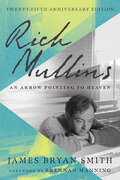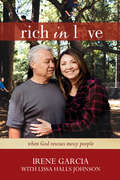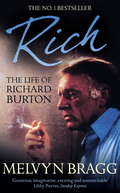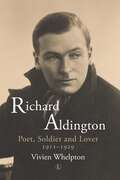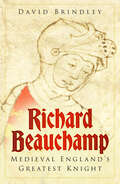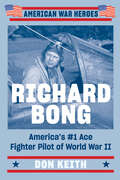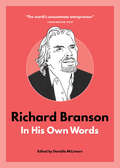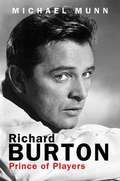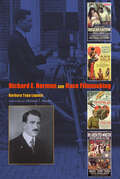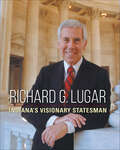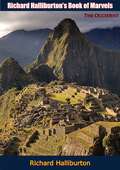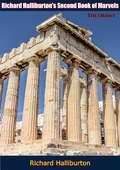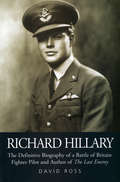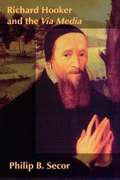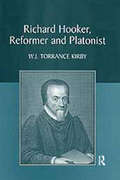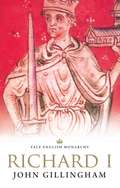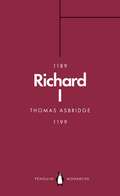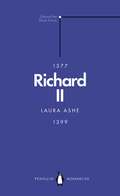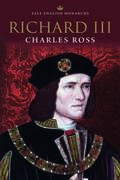- Table View
- List View
Rich Mullins: An Arrow Pointing to Heaven
by James Bryan SmithExperience Rich Mullins's Legacy of Joy and Real CompassionBeloved contemporary Christian musician Rich Mullins lived his life with abandon for God, leaving the spotlight to teach music among a Navajo community. An accident cut his life short in 1997, but his songs and ragamuffin spirit continue to teach many.Rich Mullins: An Arrow Pointing to HeavenSee the layers of his story through reflections from friends and family, an afterword by Rich's brother David Mullins, and Smith's own bond with him. And in remembrance, be inspired to enjoy God's world as Rich did.
Rich in Love
by Lissa Halls Johnson Irene GarciaOne Step of Obedience Led to Thousands Irene and Domingo Garcia began their married lives at sixteen, already expecting a baby. Their first ten years together included Domingo's alcoholism and abuse, and Irene's desperate prayers for answers. Then a miracle happened: Domingo pleaded for forgiveness. As God healed their marriage, Irene and Domingo adopted a little girl. And a new season began for an imperfect couple who were willing to say yes to each other and to God. Over the past forty-five years, the Garcias have birthed, fostered, or adopted thirty-two children. Their story holds difficult endings as well as promising new beginnings. Above all, their story reminds us what can happen when ordinary people submit to God's call. Rich in Love is about a family cemented in hope. About a need to love the orphan. And about a God who never, ever gives up.
Rich: The Life Of Richard Burton Ebook
by Melvyn BraggRichard Burton: star. The roaring boy from the Welsh coal valleys who came to sport on the banks of the old Nile, playing great Antony to Elizabeth Taylor's Cleopatra. From the West End to Hollywood, from Camelot to Shakespeare, he drank, dazzled and despaired, playing out his life on the public stage. But there was another, quieter, off-stage Richard Burton, a face hidden from the multitude. Melvyn Bragg, allowed free access to the never-before-revealed Burton private notebooks, and with the cooperation of friends who have never spoken about him before, has brought together the private and public sides for the first time. Rich is the complete Richard Burton: a revelation.
Rich: The Life Of Richard Burton Ebook
by Melvyn BraggRichard Burton: star. The roaring boy from the Welsh coal valleys who came to sport on the banks of the old Nile, playing great Antony to Elizabeth Taylor's Cleopatra. From the West End to Hollywood, from Camelot to Shakespeare, he drank, dazzled and despaired, playing out his life on the public stage. But there was another, quieter, off-stage Richard Burton, a face hidden from the multitude. Melvyn Bragg, allowed free access to the never-before-revealed Burton private notebooks, and with the cooperation of friends who have never spoken about him before, has brought together the private and public sides for the first time. Rich is the complete Richard Burton: a revelation.
Richard Aldington: Poet, Soldier and Lover 1911-1929
by Vivien WhelptonThis is a literary biography of Richard Aldington, founding member of the Imagist Movement, poet of the First World War, author of 'Death of a Hero' and a biography of D.H. Lawrence. Aldington's is an extraordinary human story dealing with contemporary issues, such as confrontation of sexual mores of the day and the impact of his soldier experience on his life and work. There hasn't been a recent biography of Aldington, the only one of the war poets not to have one. With the interest in the First World War increasing as we near the centenary, the time is right for this book. This biography explores the relationships of Aldington with other prominent literary figures: Ezra Pound, Herbert Read, T.S. Eliot, D.H. Lawrence, and his unsuccessful marriage with H.D. This first instalment of a hopefully two-volume biography covers Aldington's life and work up to 1929. It investigates the years 1911-1915 in which Aldington helped found Modernism and formed relationships with other Modernists, the years 1916-19 when his life fell apart after his soldier experience, the years 1920-28 when he tried to re-establish his literary career, laid the foundations of modern literary criticism, and his writing of Death of a Hero at the end of the decade, a blistering attack on all that had made the war possible. Offical Blurb: The story of Richard Aldington, outstanding Imagist poet and author of the bestselling war novel, Death of a Hero (1929), takes place against the backdrop of some of the most turbulent and creative years of the twentieth century. Vivien Whelpton provides a remarkably detailed and sensitive portrayal of the writer from early adolescence. His life as a stalwart of the pre-war London literary scene, as a soldier, and in the difficult aftermath of the First World War is deftly rendered through a careful and detailed analysis of the novels, poems and letters of the writer himself and his close circle of acquaintance. The complexities of London's Bohemia, with its scandalous relationships, social grandstanding and incredible creative output, are masterfully untangled, and the spotlight placed firmly on the talented group of poets christened by Ezra Pound as 'Imagistes'. The author demonstrates profound psychological insight into Aldington's character and childhood in her nuanced analysis of his post-war survivor's guilt, and consideration of the three most influential women in his life: his wife, the gifted American poet, H.D.; Dorothy Yorke, the woman he left her for; and Brigit Patmore, his brilliant and fascinating older mistress.Richard Aldington: Poet, Soldier and Lover vividly reveals Aldington's warm and passionate nature and the vitality which characterised his life and works, concluding with his triumphant personal and literary resurrection with the publication of Death of a Hero.
Richard Bancroft and Elizabethan Anti-Puritanism
by Patrick CollinsonThis major new study is an exploration of the Elizabethan Puritan movement through the eyes of its most determined and relentless opponent, Richard Bancroft, later Archbishop of Canterbury. It analyses his obsession with the perceived threat to the stability of the church and state presented by the advocates of radical presbyterian reform. The book forensically examines Bancroft's polemical tracts and archive of documents and letters, casting important new light on religious politics and culture. Focussing on the ways in which anti-Puritanism interacted with Puritanism, it also illuminates the process by which religious identities were forged in the early modern era. The final book of Patrick Collinson, the pre-eminent historian of sixteenth-century England, this is the culmination of a lifetime of seminal work on the English Reformation and its ramifications.
Richard Beauchamp: Medieval England's Greatest Knight
by David Brindley‘An avaricious knight errant with a taste for the spectacular’ or ‘one of the few upright and honest figures in these difficult years’?Contemporary views of the most colourful, wealthy and powerful knight of medieval England varied wildly, and they continue to do so today. Richard Beauchamp, Earl of Warwick, was at the centre of power in the first half of the fifteenth century and, as Henry V’s closest friend, accompanied the English warrior king to France to pursue the English claim to the French Crown in the Hundred Years War.Richard Beauchamp had an unrivalled reputation for his skills in the strategy of war and diplomacy, and secured Normandy in 1420. He arranged Henry V’s marriage and, following the king’s death, was appointed as Henry VI’s tutor and guardian. In 1431 he encouraged the ecclesiastical court of the Inquisition to try to burn Joan of Arc at the stake for heresy. In Richard Beauchamp, David Brindley pens a fascinating biography of this medieval chivalric hero.
Richard Bong: America's #1 Ace Fighter Pilot of World War II (American War Heroes)
by Don KeithThe heroic true story of Major Richard Bong, America&’s greatest fighter pilot of the Pacific War and the nation&’s top flying ace of World War IIArriving as a fresh US Army Air Forces pilot in New Guinea in late 1942, Richard Bong wasted no time taking on the Japanese, shooting down two planes in an early skirmish—an action that earned him a Silver Star. Over the next two years, Bong would amass the US armed forces&’ most impressive record of aerial victories of the entire war, surpassing even the great Eddie Rickenbacker&’s World War I tally and notching forty kills. In December 1944, he was personally awarded the Medal of Honor by General Douglas MacArthur. Now acclaimed author Don Keith recounts the remarkable saga of Bong&’s war years as well as his tragic death while serving as a test pilot.
Richard Branson: In His Own Words (In Their Own Words)
by Danielle McLimoreA look into the mind of &“the world&’s consummate entrepreneur&” through his quotes on leadership, branding, innovation, social responsibility, and more (Huffington Post). Richard Branson, who has been called &“England&’s most outrageous billionaire,&” is also one of the world&’s most successful business leaders. Since the age of 16, when he founded Student magazine, Branson has been creating companies and finding innovative ways to grow them into the prodigious conglomerate known as the Virgin Group. At the age of 20, Branson founded a mail-order record retailer. Two years later he built a recording studio where the first artist signed to his Virgin label, Mike Oldfield, recorded the haunting soundtrack to The Exorcist. Decades later, industries as varied as entertainment (Virgin Music), retail (Virgin Megastores), transportation (Virgin Airlines), and telecommunications (Virgin Mobile) all bear Branson&’s business moniker. For the first time, the most thought-provoking, revealing, and inspiring quotes from Branson have been compiled in a single book. Updated and redesigned since its initial publication in 2013 as Virgin Rebel: Richard Branson in His Own Words, this new edition is a comprehensive guidebook to the inner workings of the Virgin Group chairman and founder. Hundreds of Branson&’s best quotes, comprising thoughts on business, music, entrepreneurship, politics, exploration, and life lessons, provide an intimate and direct look into the mind of this modern business icon. &“I have no secret. There are no rules to follow in business. I just work hard and, as I always have done, believe I can do it.&” —Screw It, Let&’s Do It, page 30
Richard Burton: Prince of Players
by Michael MunnThe whirlwind life of one of old Hollywood’s biggest stars.From the depths of a small mining village in Wales to a star of Hollywood’s silver screen, Richard Burton broke every rule in his quest for the American Dream. Burton made sure that he sipped the cup of life at its fullest. Twice married to Elizabeth Taylor, he is now revealed to have been one of Marilyn Monroe’s secret lovers. The details of these licit and illicit relationships with Hollywood’s most iconic stars will titillate and shock both newcomers to Burton’s story and those already familiar with his fame. Munn’s biography covers everything from Burton’s early days on the London stage, to his star performance in Broadway’s Camelot, to his wild nights in Hollywood with the likes of Errol Flynn, Peter O’Toole, and Frank Sinatra. Burton was known for his charisma, his explosive temper, his excessive carousing, and, above all, his stunning command of stage and screen. This first-ever look at the real Richard Burton is a must-read for any follower of film, history, and the rise of celebrity in America.Skyhorse Publishing, along with our Arcade, Good Books, Sports Publishing, and Yucca imprints, is proud to publish a broad range of biographies, autobiographies, and memoirs. Our list includes biographies on well-known historical figures like Benjamin Franklin, Nelson Mandela, and Alexander Graham Bell, as well as villains from history, such as Heinrich Himmler, John Wayne Gacy, and O. J. Simpson. We have also published survivor stories of World War II, memoirs about overcoming adversity, first-hand tales of adventure, and much more. While not every title we publish becomes a New York Times bestseller or a national bestseller, we are committed to books on subjects that are sometimes overlooked and to authors whose work might not otherwise find a home.
Richard E. Norman and Race Filmmaking
by Michael Martin Barbara Tepa LupackIn the early 1900s, so-called race filmmakers set out to produce black-oriented pictures to counteract the racist caricatures that had dominated cinema from its inception. Richard E. Norman, a southern-born white filmmaker, was one such pioneer. From humble beginnings as a roving "home talent" filmmaker, recreating photoplays that starred local citizens, Norman would go on to produce high-quality feature-length race pictures. Together with his better-known contemporaries Oscar Micheaux and Noble and George Johnson, Richard E. Norman helped to define early race filmmaking. Making use of unique archival resources, including Norman's personal and professional correspondence, detailed distribution records, and newly discovered original shooting scripts, this book offers a vibrant portrait of race in early cinema.
Richard G. Lugar, Statesman of the Senate
by John T. ShawTwo-time chairman of the Senate Foreign Relations Committee, Richard G. Lugar has been one of the most widely respected foreign policy experts in Congress for over three decades. In this illuminating profile, John T. Shaw examines Lugar's approach to lawmaking and diplomacy for what it reveals about the workings of the Senate and changes in that institution. Drawing on interviews with Lugar and other leading figures in foreign policy, Shaw chronicles Lugar's historic work on nuclear proliferation, arms control, energy, and global food issues, highlighting the senator's ability to influence American foreign policy in consequential ways. The book presents Lugar's career as an example of the role Congress can play in the shaping of foreign policy in an era of a strong executive branch. It demonstrates the importance of statesmanship in contemporary American political life while acknowledging the limitations of this approach to governance.
Richard G. Lugar: Indiana's Visionary Statesman (Special Publications of the Lilly Library)
by Dan Diller Sara StefaniIn the senatorial election of 1976, the people of Indiana offered a gift not only to the nation but to the world. For 36 years, Richard G. Lugar tirelessly and with great deliberation worked to advance causes of peace, health, and economic prosperity at home and abroad. This included the widespread elimination of nuclear, chemical, and biological weapons through the Nunn-Lugar Cooperative Threat Reduction Program. Respected and even beloved for his global initiatives and bipartisan efforts, in 2013 Lugar was awarded the Presidential Medal of Freedom in the United States and, in England, the rank of Knight Commander of the Most Excellent Order of the British Empire. Featuring insightful commentary and memorable photographs spanning the entirety of Senator Lugar's career, Richard G. Lugar: Indiana's Visionary Statesman is an indispensable companion to an exhibition of his papers at the world-famous Lilly Library at Indiana University.
Richard Halliburton’s Book of Marvels: The Occident
by Richard HalliburtonBoys and girls all over the world know the name of Richard Halliburton. They have heard grown-ups talk about The Royal Road to Romance, The Glorious Adventure, New Worlds to Conquer, The Flying Carpet and Seven League Boots. These books have broken records in the field of travel and adventure. They are bestsellers year in and year out.Now Mr. Halliburton has written a book just for his younger friends (but just to try and keep father and mother or uncle and aunt away from it!) and in it he has kept a promise he made to himself when he studied geography in school. In those days his eager wish was to travel, to see the places he had read about. He swore that when he became a man he would see that his sons not only studied their geography but lived it too. Now he has been to the four corners of the world and beheld the wonders of nature and man. But he is a bachelor, and has no sons of his own. So he has adopted all boys and girls and here he takes them with him on a personally conducted tour to live geography with him—the most thrilled geography anyone could imagine.This book represents the cream of his adventures. Beginning with the wonders of our own continent we travel and adventure with him to South America and to Europe.No dramatic incident, no fascinating legend relating to his marvels has been omitted. Richard Halliburton has spared himself no trouble, no expense to make this book complete and beautiful. The illustrations are many and inspiring. Out of his first-hand knowledge of the notable scenes and works of our world, he has chosen those that have most appealed to his own imagination, and with his story-telling gift, simple, direct, enthusiastic, he makes them live to the imagination of all boys and girls. For he has the heart of a boy and he speaks to the heart of youth.
Richard Halliburton’s Second Book of Marvels - The Orient
by Richard HalliburtonBoys and girls all over the world know the name of Richard Halliburton. They have heard grown-ups talk about The Royal Road to Romance, The Glorious Adventure, New Worlds to Conquer, The Flying Carpet and Seven League Boots. These books have broken records in the field of travel and adventure. They are bestsellers year in and year out.Now Mr. Halliburton has written a book just for his younger friends (but just to try and keep father and mother or uncle and aunt away from it!) and in it he has kept a promise he made to himself when he studied geography in school. In those days his eager wish was to travel, to see the places he had read about. He swore that when he became a man he would see that his sons not only studied their geography but lived it too. Now he has been to the four corners of the world and beheld the wonders of nature and man. But he is a bachelor, and has no sons of his own. So he has adopted all boys and girls and here he takes them with him on a personally conducted tour to live geography with him—the most thrilled geography anyone could imagine.Following on from his Book of Marvels: The Occident, this present volume provides another exciting tour for school students—introducing the people, religions, architecture, customs, and scenery from Greece to Mt. Fuji in Japan, multi-cultural regions then called “The Orient,” complete with maps of his travel routes.No dramatic incident, no fascinating legend relating to his marvels has been omitted. Richard Halliburton has spared himself no trouble, no expense to make this book complete and beautiful. The illustrations are many and inspiring. Out of his first-hand knowledge of the notable scenes and works of our world, he has chosen those that have most appealed to his own imagination, and with his story-telling gift, simple, direct, enthusiastic, he makes them live to the imagination of all boys and girls. For he has the heart of a boy and he speaks to the heart of youth.
Richard Hillary: The Definitive Biography of a Battle of Britain Fighter Pilot and Author of The Last Enemy
by David RossThe authoritative biography of the WWII ace fighter pilot, hero of the Battle of Britain and author of the classic wartime memoir The Last Enemy. As both a legendary flying ace and an accomplished author, Richard Hillary achieved a unique kind of immortality during his tragically short life. Born in Australia and raised in England, he attended Oxford University before joining the Royal Air Force at the outbreak of World War II. Flying Spitfires in the 603 Squadron, he became an ace in the Battle of Britain. Though he managed to survive being shot down in September 1940, he suffered severe burns to his face and hands. It was during his long and painful recovery that Hillary wrote his masterpiece, The Last Enemy. Then, anxious to return to flying, he died when his Bristol Blenheim bomber crashed in &‘mysterious&’ circumstances in 1943. Cutting through myth and misinformation, biographer David Ross draws on extensive archival research, including from the Richard Hillary Trust Archive in Oxford, as well as interviews with Hillary&’s contemporaries. This complete biography also features many previously unseen photographs.
Richard Hooker and the Via Media
by Philip B. SecorRICHARD HOOKER (1554-1600) is the pioneer theologian of the Anglican/Episcopal religious tradition. To the present day, his advocacy of a broad tolerant middle way (via media) between the extremes of fundamentalist Protestantism and the more rigid expressions of Roman Catholicism is a hallmark of Anglicans and Episcopalians around the globe. For all of his importance, little has ever been known about Hooker's life and the manner in which his ideas developed. With the appearance of Dr. Secor's biography, thoroughly researched over many years, yet written in a style that makes Hooker accessible to the general reader, this great figure emerges at last into the light of history as a full-blooded Elizabethan character endowed with all of the very human strengths and weaknesses of that dynamic and formative age.
Richard Hooker, Reformer and Platonist
by W.J. Torrance KirbyThis book explores key aspects of Richard Hooker's philosophical and theological discourse in the context of currents of thought prevalent in the 'Magisterial Reformation' of the sixteenth century. Hooker's treatment of natural law, his dependence upon the philosophical discourse and traditional cosmology of Christian Neoplatonism, and his appeal to the authority of patristic sources, are all closely examined. Challenging the received 'exceptionalist' model of much of the twentieth-century interpretation of Hooker, in particular the concept of his supposed defence of the English Reformation as striking a 'via media' between Rome and mainstream Protestant reform, W.J. Torrance Kirby argues that Hooker adheres to principles of 'magisterial' reform while building upon the assumptions of a distinctively Protestant version of Platonism.
Richard I
by John GillinghamNeither a feckless knight-errant nor a king who neglected his kingdom, Richard I was in reality a masterful and businesslike ruler. In this wholly rewritten version of a classic account of the reign of Richard The Lionheart, John Gillingham scrutinizes the reasons for the King's fluctuating reputation over successive centuries and provides a convincing new interpretation of the significance of the reign. This edition includes a complete annotation and expanded bibliography.
Richard I: The Crusader King (Penguin Monarchs)
by Thomas AsbridgeRichard I's reign is both controversial and seemingly contradictory. One of England's most famous medieval monarchs and a potent symbol of national identity, he barely spent six months on English soil during a ten-year reign and spoke French as his first language. Contemporaries dubbed him the 'Lionheart', reflecting a carefully cultivated reputation for bravery, prowess and knightly virtue, but this supposed paragon of chivalry butchered close to 3,000 prisoners in cold blood on a single day. And, though revered as Christian Europe's greatest crusader, his grand campaign to the Holy Land failed to recover the city of Jerusalem from Islam.Seeking to reconcile this conflicting evidence, Thomas Asbridge's incisive reappraisal of Richard I's career questions whether the Lionheart really did neglect his kingdom, considers why he devoted himself to the cause of holy war and asks how the memory of his life came to be interwoven with myth. Richard emerges as a formidable warrior-king, possessed of martial genius and a cultured intellect, yet burdened by the legacy of his dysfunctional dynasty and obsessed with the pursuit of honour and renown.
Richard II and the Rebel Earl
by A. K. GundyThe reign of Richard II and the circumstances of his deposition have long been subject to intense debate. This new interpretation of the politics of the late-fourteenth century offers an in-depth survey of Richard's reign from the perspective of one of the leading nobles who came to oppose him, Thomas Beauchamp, the Appellant Earl of Warwick. This is the first full-length study of one of Richard II's opponents to explore not only why the Earl rebelled against the King, but also why Richard lost his throne. Rather than offering the traditional explanation of a subject grown too mighty, Alison Gundy sets Warwick's rule in the context of the political and constitutional framework of the period. The interplay of local and national events helps to reveal Warwick's motives as a long-serving member of the nobility faced with a king determined to rule in a manner contradictory to contemporary political structures.
Richard II: A Brittle Glory (Penguin Monarchs)
by Laura AsheRichard II (1377-99) came to the throne as a child, following the long, domineering, martial reign of his grandfather Edward III. He suffered from the disastrous combination of a most exalted sense of his own power and an inability to impress that power on those closest to the throne. Neither trusted nor feared, Richard battled with a whole series of failures and emergencies before finally succumbing to a coup, imprisonment and murder.Laura Ashe's brilliant account of his reign emphasizes the strange gap between Richard's personal incapacity and the amazing cultural legacy of his reign - from the Wilton Diptych to Sir Gawain and the Green Knight, Piers Plowman and The Canterbury Tales.
Richard III
by Charles RossRichard III ruled England for a mere twenty-six months, yet few English monarchs remain as compulsively fascinating, and none has been more persistently vilified. In his absorbing and universally praised account, Charles Ross assesses the king within the context of his violent age and explores the critical questions of the reign: why and how Richard Plantagenet usurped the throne; the belief that he ordered the murder of "the Princes in the Tower"; the events leading to the battle of Bosworth in 1485; and the death of the Yorkist dynasty with Richard himself. In a new foreword, Professor Richard A. Griffiths identifies the attributes that have made Ross's account the leading biography in the field, and assesses the impact of the research published since the book first appeared in 1981. "A fascinating study on a perennially fascinating topic… the base against which will be measured any future research."--Times Higher Education Supplement
